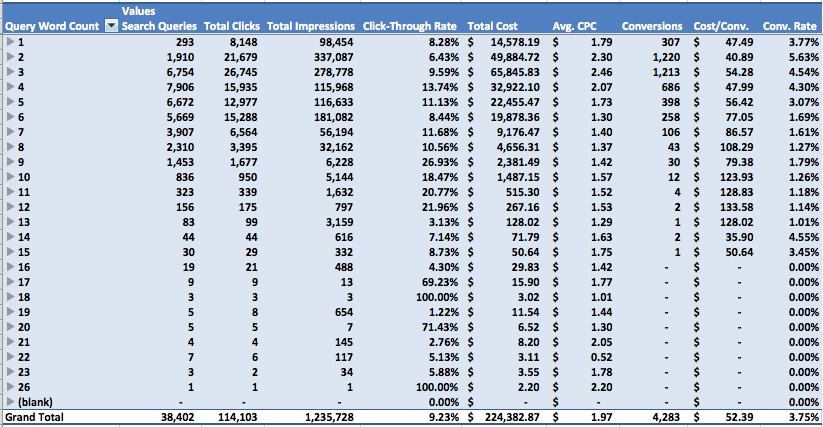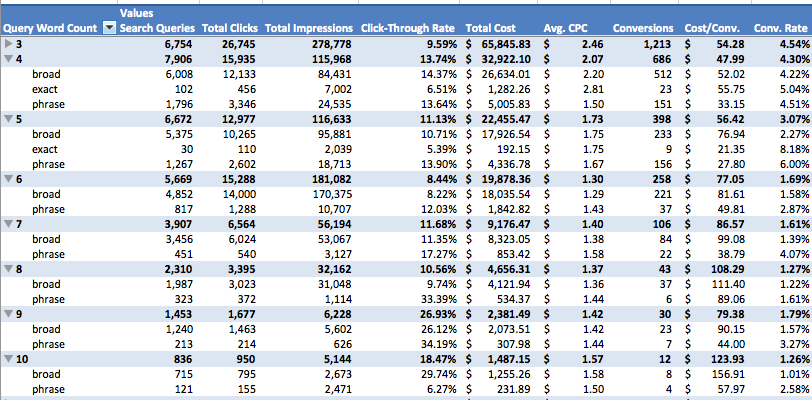A great long tail keyword is one of the prized possessions in PPC. If you’ve found an awesome keyword that no one else is using, you can make a lot of profit in running unopposed. But there’s a question I’ve always wondered: just how long should you let your keywords get?
To help you understand what I’m talking about, this is a common graphical representation of long tail keywords:

In this case, the green is representative of your key terms. They’re comprised of shorter, generic keywords that are highly relevant to your industry, or branded keywords that are highly specific to your business. The yellow represents your long tail keywords – longer keywords with many words and/or characters, with less competition the longer they get.
Once you get past the obvious head terms for your account and industry, expanding that long tail is one of the last great frontiers for account expansion. But just how long of a tail should you pursue?
To help answer that question, I compiled a little bit of data for you from one of my accounts. It’s a very high volume account, and the numbers were taken from a 30-day snapshot. For our purposes today, the CPA goal in this account is $50.
To start, I’ve broken down my keyword data over 30 days by the count of words in each keyword.

There’s an even proportion of broad, phrase, and exact match throughout the entire account, hence the total keyword values being slightly high. However, the important thing to note in this example is the amount of volume found on those 4+ keyword terms. Roughly 1/3rd of our conversions came from those longer terms – exactly in line with the graph you saw earlier. The efficiency is actually slightly lower than the core terms, but that’s due to many conversions in the 1 and 2-word keyword group coming from branded product terms.
The other important thing to note is that even with 3,006 5-word keywords (many of those even broad match terms), impression volume sharply drops once your keywords get that long. It’s all about diminishing returns. The longer your keywords get, the more difficult it is to find clicks and impressions on those terms. It’s akin to searching for a needle in a haystack.
Now, it’s one thing to actually target those keywords in your account – it’s quite another to examine what queries people are searching for. To that end, here are the corresponding results for the Search Query Report for the same account, over the same time span:

In this case, we still see the same loss of efficiency the longer the queries get. Ironically, this also starts at that same 4 and 5-word mark. But is that due entirely to the query length, or is there another factor in play?
(There is.)

Here we see some of the difficulties in working with longer queries and keywords. When you get to these longer queries, it becomes more difficult to match them with any keywords outside of the usual broad match terms. In many cases, these queries will be low search volume terms with impressions in the single digits – they just happened to convert in that singular instance. However, in the rare cases that they were able to convert on a phrase or exact match keyword, they did so at a Conversion Rate and Cost Per Conversion far better than that of their broad match counterparts. For those queries, it might behoove you to do some more research and add them in.
On the other hand, optimizing those queries with 7+ words or more in them would only have a marginal impact on overall performance. So in the end, it’s all about time management – and it depends entirely on just how far down this long tail rabbit hole you want to go.
I’m not quite done though. In doing my research for this post, I came across quite a lot of people discussing character length as well as word count. This is doubly important in an Enhanced Campaigns world, as typing a query on a mobile device can be quite painful. So let’s examine the same tables above, instead broken down by character count. Here are the keyword statistics:

We see again the same breakdown as before – 26-40 character keywords account for roughly 1/3rd of the conversion volume in the account, with impression volume severely dropping at the 40+ mark.
And what about the queries?

We see the exact same breakdown in terms of performance on the query side of things. Meaning that there’s a severe case of diminishing returns as your keywords grow longer in terms of both word length and character length – and that’s reflected in the queries as well.
Here’s the main takeaway: the point of diminishing returns for a long tail keyword (in this account) comes after roughly six words to a keyword, and above 40 characters. That means you have lot of room to maneuver when it comes to long tail keyword expansion. Just don’t go crazy with the 8-word, 50-character keywords. Do the same analysis on your own accounts, and learn where your own diminishing returns kick in!
What about you, PPC Heroes and Heroines? Any favorite methods to find those hidden long tails that have served you so well? Have any of you, like me, thought you’d find success with a ten-word keyword? Have you actually found success with a ten-word keyword? Let us know in the comments and, as always, thanks for reading!



